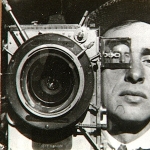Background
Vertov was born David Abelevich Kaufman into a family of Jewish lineage in Białystok, Poland, then a part of the Russian Empire. He Russified his Jewish name David and patronymic Abelevich to Denis Arkadievich at some point after 1918.

filmmaker scriptwriter theorist
Vertov was born David Abelevich Kaufman into a family of Jewish lineage in Białystok, Poland, then a part of the Russian Empire. He Russified his Jewish name David and patronymic Abelevich to Denis Arkadievich at some point after 1918.
Vertov studied music at Białystok Conservatory until his family fled from the invading German Army to Moscow in 1915. The Kaufmans soon settled in Petrograd, where Vertov began writing poetry, science fiction and satire. In 1916-1917 Vertov was studying medicine at the Psychoneurological Institute in Saint Petersburg and experimenting with "sound collages" in his free time. He eventually adopted the name "Dziga Vertov", which translates loosely from Ukrainian as 'spinning top'.
As a newsreel cameraman during the Russian Civil War, Vertov filmed events that were the basis for such factual films as Godovshchina revolyutsii (1919; The Anniversary of the October Revolution) and Boi pod Tsaritsynom (1920; Battle of Tsaritsyn). At age 22 he was the director of a government cinema department. The following year he formed the Kinoki (the Film-Eye Group), which subsequently issued a series of manifestos against theatricalism in films and in support of Vertov’s film-eye theory. In 1922 the group, led by Vertov, initiated a weekly newsreel called Kino-pravda (“Film Truth”) that creatively integrated newly filmed factual material and older news footage.
The subject matter of Vertov’s later feature films is life itself; form and technique are preeminent. Vertov experimented with slow motion, camera angles, enlarged close-ups, and crosscutting for comparisons; he attached the camera to locomotives, motorcycles, and other moving objects; and he held shots on the screen for varying lengths of time, a technique that contributes to the rhythmic flow of his films. Outstanding among Vertov’s pictures are Shagay, Sovyet! (1925; Stride, Soviet!), Shestaya chast mira (1926; A Sixth of the World), Odinnadtsatyi (1928; The Eleventh), Chelovek s kinoapparatom (1928; The Man with a Movie Camera), Simfoniya Donbassa (1930; Symphony of the Donbass), and Tri pesni o Lenine (1934; Three Songs of Lenin). Vertov later became a director in the Soviet Union’s Central Documentary Film Studio. His work and his theories became basic to the rediscovery of cinéma vérité, or documentary realism, in the 1960s.
(For the Russian filmmaker and film theorist Dziga Vertov ...)
(Pioneer of political documentary and inventor of cinéma v...)
(Lines of Resistance is a major collection of little-known...)
(Dziga Vertov was one of the greatest innovators of Soviet...)
Vertov's legacy still lives on today. His ideas are echoed in cinéma vérité, the movement of the 1960s named after Vertov's Kino-Pravda. The 1960s and 1970s saw an international revival of interest in Vertov.
The independent, exploratory style of Vertov influenced and inspired many filmmakers and directors like the Situationist Guy Debord and independent companies such as "Vertov Industries," in Hawaii. The Dziga Vertov Group borrowed his name. In 1960, Jean Rouch used Vertov's filming theory when making Chronicle of a Summer. His partner Edgar Morin coined Cinéma vérité term when describing the style, using direct translation of Vertov’s KinoPravda.
The Free Cinema movement in the United Kingdom during the 1950s, the Direct Cinema in North America in the late 1950s and early 1960s, and the Candid Eye series in Canada in the 1950s, all essentially owed a debt to Vertov.
Vertov's brother Boris Kaufman was a noted cinematographer who worked much later for directors such as Elia Kazan and Sidney Lumet in the United States. (He won an Oscar for his work on On the Waterfront.) His other brother, Mikhail Kaufman, worked as Vertov's cinematographer until he became a documentarian in his own right. Mikhail Kaufman's directorial debut was the film In Spring made in 1929. In September 1929, Vertov married his long-time collaborator Elizaveta Svilova.
